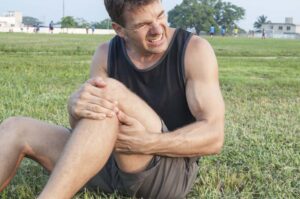 Did you know that your hamstrings are actually made up of three muscles? If you recently injured or overstressed one of the muscles that make up your hamstrings then you will definitely notice how that impacts your movements. The hamstrings are located on the back of your legs just beneath your buttocks. The hamstring muscles are what allow you to bend your knees, tilt your pelvis, squat, run, and jump. An injury to your hamstring can affect your hips, legs, and knees because of how much these muscles are involved in your everyday movements. Some hamstring injuries may require physiotherapy to help you recover faster and also to prevent future injuries.
Did you know that your hamstrings are actually made up of three muscles? If you recently injured or overstressed one of the muscles that make up your hamstrings then you will definitely notice how that impacts your movements. The hamstrings are located on the back of your legs just beneath your buttocks. The hamstring muscles are what allow you to bend your knees, tilt your pelvis, squat, run, and jump. An injury to your hamstring can affect your hips, legs, and knees because of how much these muscles are involved in your everyday movements. Some hamstring injuries may require physiotherapy to help you recover faster and also to prevent future injuries.
Understanding Hamstring Injuries
Most injuries that occur to the hamstrings are muscle sprains that can be minimal, partial, or complete. Most mild cases of a hamstring strain will resolve on their own after a few days and involve minimal damage to the muscles. Moderate hamstring strains can cause pain, affect your functioning, and hinder some movements until you heal. If you suffer a severe hamstring strain or contusion, you may have ended up rupturing the soft tissue, which can cause significant pain and cause you to not be able to move those muscles at all. Mild and moderate hamstring injuries are some of the most common injuries among athletes. These types of injuries are typically associated with pain, swelling, stiffness, and reduced range of motion.
Diagnosing a Hamstring Injury
Your doctor will perform a physical exam to diagnose a hamstring injury, where they will look for swelling and areas of tenderness. Your doctor may also assist you in moving your leg in certain positions to help determine what part of the hamstring has been damaged and which of the muscles are affected. Your doctor will also want to check for any damage to the ligaments or tendons in the back of the leg. In more serious cases, your doctor may also request a diagnostic imaging test like an X-ray to rule out a fracture or an MRI to get a clearer picture of any tears in the muscles or tendons.
Healing from a Hamstring Injury
The first step of the healing process after a hamstring injury is to manage your pain and reduce swelling in the area. Most mild hamstring injuries can be managed at home as you rest and ice the area. Resting and using assistive devices like a crutch can help take the pressure and weight off of the injury, while cold compresses can help reduce pain and swelling. You may also take pain medications to help experience temporary pain relief and to help address inflammation in the area. After swelling and inflammation have gone down, your doctor may also recommend physiotherapy stretches and exercises to help provide strength, stability, and flexibility to the area.
Examples of Hamstring Strengthening Exercises
Physiotherapy exercises will help strengthen damaged hamstring muscles and help you develop more stability and flexibility in the future. Here are three examples of hamstring strengthening exercises that may help you recover from a hamstring injury and prevent future injuries.
Glute Bridges
For this exercise, you will lie on your back with your knees bent and feet on the floor. Engage your core muscles as you press your heels into the floor, squeeze the buttocks muscles, and lift your hips toward the ceiling. Keep your upper body and back flush to the ground throughout this process. One rep of glute bridges involves raising your hips and pelvis to the ceiling and pausing before returning to the start.
Exercises with Resistance Bands
You may also incorporate resistance bands around the thighs for a variety of exercises, including glute bridges. Loop a resistance band around both your thighs and engage your core as you lower into a squat position. Then practice taking crab steps in one direction before returning in the other direction. These simple movements with a resistance band can help strengthen the muscles and also help with stability.
Exercises with a Stability Ball
Utilize a stability ball in workouts to help strengthen your hamstring muscles. Lie on your back and bend your knees so that your knee joint forms a right angle. Place your feet on the top of the ball and slowly roll the ball away from your body so your legs straighten, then engage the core to roll the ball back.
To learn more about physiotherapy exercises that can help you recover from a hamstring injury, visit AICA Orthopedics in College Park today!